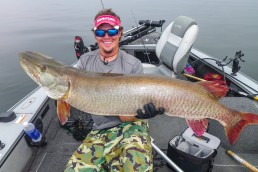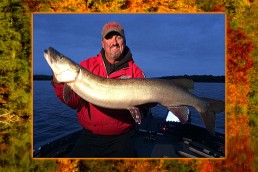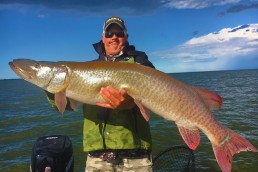Fall Muskie Fishing 101
SHARE THIS POST
In the Midwest, we enjoy experiencing all four seasons that Mother Nature offers. As we progress into August, the amount of daylight each day grows less and less. We also see chilly mornings and fog forming in lowlands and across lakes. The sunrises and sunsets seem intense, and summer boat traffic slowly recedes as the water temperatures slowly drop. These are all nature’s indications that fall is coming, and it is time to prepare for winter.
In the world of the mighty muskie, this time of year kick-starts a feeding binge that lasts until the season closes. In a muskie angler’s world, this is the time to bundle up and pursue the heaviest muskies of the season.
When chasing fall muskies for the first time, reliable gear is a must. Having the proper rods, reels and fishing line will ensure that your personal best muskie does not get away due to mechanical failure.
When it comes to rods, the trend is toward long, 8- to 9-foot rods with a heavy or extra-heavy action, such as the Fenwick Elite Tech Predator 9-foot extra heavy casting rod. These rods allow you to throw heavier baits with ease, and execute proper boatside maneuvers to trick muskies at the boat. Pairing a good reel with any rods is a must. Pair it with a reel that is built specifically to handle the abuse of muskie fishing, like the Abu Garcia Revo Beast.
Last, but certainly not least, pick out a good line and leader combination. Using a heavy braided line like Berkley X9 Braid is highly recommended. Heavy braid is able to withstand fishing around rocks and weeds, and the abuse of giant fish. Braided line also offers superior durability, strong hooksets and extra sensitivity.
Finally, choose a leader that’s made of at least 130-pound-test fluorocarbon or wire. Each material has pros and cons, and your choice depends on personal preference.
There is an old saying in fishing that goes, “You can not catch them from the couch.” You need to spend time on the water; taking time to learn a lake even before launching the boat can be a game-changing event. Whether looking for locations on the water or by doing some pre-game research, there are certain structural features to seek out.
Main lake rock piles that top out between 3 and 6 feet of water, and shoreline rock that immediately adjoins deep water, are prime fall locations. Muskies use rocks all the time to ambush prey, and not all rocks are created equal.
Big boulders typically hold the majority of the fish, likely because they provide the most cover. A main lake reef usually has small rocks, and then a congregation of larger rocks, which is a place to mark on your GPS.
When they’re not atop the rocks, muskies may be holding off the deeper edges of reefs or shorelines, so do not skip casting out over deep water. These fish are usually suspended about 10 to 15 feet below the surface, waiting for bait like ciscoes to move in from open water. After fishing an area a few times, pay attention to where the fish are holding, as it can apply to other locations in that same body of water.
Weeds are a second classic fall muskie location, and being picky about which weeds you fish will put more slime in your net.
Are you enjoying this post?
You can be among the first to get the latest info on where to go, what to use and how to use it!
Coontail, cabbage, and pencil reeds all harbor primary forage, and the muskies do not miss out on the opportunities to dine. Coontail and cabbage beds that are located in 8 to 15 feet of water are beautiful spots to catch a fall giant. Look for pockets and inside turns in weed beds, as this is where a typical muskie will dash out from ambush to nail passing prey. Pencil reeds also attract muskies—especially deep reed beds in 4 to 6 feet of water. Areas where the pencil reeds form a point are great spots.
Lure selection need not be complicated. There are two factors to consider: depth and cover.
Muskies can use a variety of depths and cover in the fall. When fishing the sharp breaks where large baitfish live, I like throwing baits like a Svartzonker McRubber, Medusa or Bulldawg. You can buy these baits in huge sizes, but those are not always necessary.
Another plus to using these lures is, when you fish them fast, they run pretty shallow, but when you slow them down, they can go as deep as you would like; just pause to allow your bait to sink to the desired depth level before beginning your retrieve. They mimic the abundant forage that muskies are feeding on, and are overall excellent choices for any time of year.
When fishing shallow water or weeds in the fall, crankbaits/twitch baits, large bucktails and glide baits can be very effective. They perform well in weeds, rocks and sand areas, because they do not typically need to go deep to be effective. When cranked slowly, large bucktails give off tons of flash and vibration, and this can attract muskies from a long way out. If the water is cold or the fish are not responding to large baits, switch gears to a slower presentation like a twitch or glide bait. It can make your day.
Contour-trolling sharp breaks with large crankbaits goes hand-in-hand with fall muskie fishing. Trolling can be effective for many reasons, but most people feel that it keeps the bait in the strike zone longer, and covers much more water than casting. Many different companies make muskie-specific crankbaits, such as SuperNatural Big Baits, who construct their lures to be fished around rocks or in open water.
When looking for an excellent fall trolling run, focus on sharp breaks that lead to deep water, where plenty of baitfish are present. Don’t get hung up on keeping your boat at a certain depth or speed, at least until you establish some sort of pattern. Vary your speed, lure depth and boat depth until Mother Nature gives you a sign. Also, keep an eye on your electronics to look for predator fish and baitfish. Let the fish tell you what they want, and then hone your approach from there.
Muskie fishing during the last months of the season in Minnesota is very similar to hunting a large buck. Spending time in the proper areas, presenting lures at the right times, and being out on the water during prime feeding windows is critical for success. The heaviest fish in the lake are available, and are most likely in an awesome feeding mode.
But it also can be frustrating, because even on the best of muskie waters, you only get so many bites, even on a good day! Overcoming the frustration, and keeping baits in the water, will lead to success, and hopefully, a fall giant!
Understanding ambush points, baitfish movements and lure presentation will further increase your chances of getting slimy. Just remember, the best way to warm up on a cold fall day is feeling the head shakes of a 40-pound-plus muskie!
MWO
SHARE THIS POST
Did you enjoy this post?
You can be among the first to get the latest info on where to go, what to use and how to use it!
Tim Hanske
Tim Hanske is a guide and pro staffer with Leisure Outdoor Adventures, a premier fishing guide service in Walker, Minn. Check them out at leisureoutdooradventures.com or call 855-562-4665.



